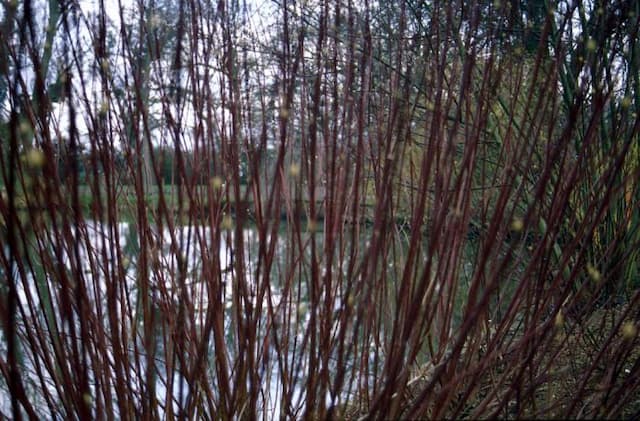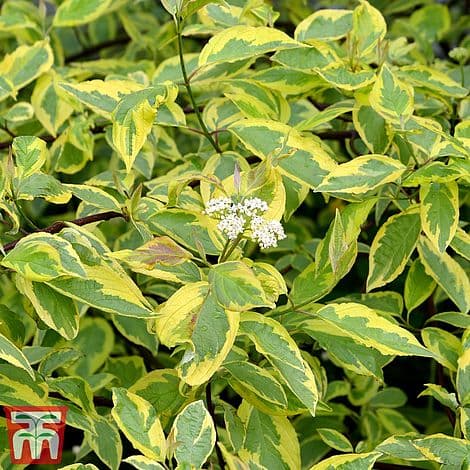Chinese dogwood Cornus kousa var. chinensis 'Wieting's Select'











ABOUT
Cornus kousa var. chinensis 'Wieting's Select', commonly known as the Chinese dogwood 'Wieting's Select', is a deciduous shrub with a distinctive appearance. The plant is characterized by its layered, horizontal branches that give it a structured yet graceful silhouette. Throughout the seasons, its leaves transform from a fresh, vibrant green to a spectacular display of autumn colors, including shades of red and purple. The true showstoppers of this plant are its star-like flowers, which are not actually flowers but rather modified leaves called bracts that surround the small, inconspicuous center flowers. These bracts are pointy and a creamy white, becoming more prominently pronounced as the season progresses. The flowers tend to bloom profusely in late spring to early summer, creating a splendid floral display that can last for several weeks. Following the flowering period, the plant produces berry-like fruits that initially appear green and gradually ripen to a pinkish-red hue. These fruits are quite attractive and can persist into late fall or even early winter, providing a visual interest as well as a food source for local birds. The bark of the Chinese dogwood 'Wieting's Select' is also noteworthy, exfoliating with age to reveal a mottled pattern of tan and gray, adding to its winter appeal. Texturally, the leaves are somewhat glossy with subtle veining, contributing to the plant's overall elegance. Its foliage, flowers, fruits, and exfoliating bark make the Chinese dogwood 'Wieting's Select' a plant with multi-seasonal interest and a distinctive appearance that can enhance any garden landscape.
About this plant
 Names
NamesSynonyms
Chinese Dogwood, Kousa Dogwood, Korean Dogwood, Japanese Dogwood, Asian Dogwood.
Common names
Cornus kousa var. chinensis 'Wieting's Select'.
 Toxicity
ToxicityTo humans
The plant known as Kousa Dogwood is generally considered non-toxic to humans. The fruit of the Kousa Dogwood is edible when ripe and is often eaten fresh or used in various culinary dishes. However, ingesting unripe fruit or large quantities might cause some individuals to experience mild stomach upset. Other parts of the plant, such as the leaves, bark, and flowers are not typically consumed and could potentially cause irritation or discomfort if ingested in large amounts due to the presence of saponins, although they are not generally considered to be dangerously poisonous.
To pets
Kousa Dogwood is also generally considered non-toxic to pets. The fruit can be eaten by dogs and is not known to cause toxic effects. While the plant is not classified as poisonous, the ingestion of large amounts of the leaves, stems, or bark could potentially cause gastrointestinal irritation or upset in some pets due to the presence of saponins. It is always advisable to prevent pets from eating plant material, as individual sensitivity could vary and the potential for obstruction or other digestive issues should be considered.
 Characteristics
CharacteristicsLife cycle
Perennials
Foliage type
Deciduous
Color of leaves
Green
Flower color
White
Height
15-20 feet (4.6-6 meters)
Spread
15-20 feet (4.6-6 meters)
Plant type
Tree
Hardiness zones
5-8
Native area
China
Benefits
 General Benefits
General Benefits- Aesthetic Appeal: Cornus kousa 'Wieting's Select', commonly known as Chinese dogwood, has a beautiful floral display with a profusion of white to pink bracts in late spring, followed by attractive raspberry-like fruits.
- Four-Season Interest: This plant offers year-round interest with flowers in spring, fruits in summer, vivid autumn foliage, and exfoliating bark in the winter.
- Wildlife Attraction: Its fruits are a food source for birds and other wildlife, making it an excellent choice for nature-friendly gardens.
- Disease and Pest Resistance: This variety has enhanced resistance to common diseases like dogwood anthracnose and is less prone to pests.
- Drought Tolerance: Once established, Chinese dogwood has good drought tolerance, reducing the need for constant watering.
- Low Maintenance: Requiring minimal pruning and care once established, this plant is ideal for gardeners looking for low-maintenance landscaping options.
- Improved Climate Resilience: 'Wieting’s Select' is known for its adaptability to various climate conditions, providing a reliable landscaping choice in different regions.
 Medical Properties
Medical Properties- Anti-inflammatory: The fruit of the Kousa dogwood (Cornus kousa) has been reported to have anti-inflammatory properties.
- Antioxidant: Kousa dogwood berries contain compounds with antioxidant effects, which can help protect cells from oxidative damage.
- Anticancer: Some studies suggest that extracts from Cornus kousa could have anticancer potential, though this is largely based on laboratory research rather than clinical studies.
- Antipyretic: Traditionally, parts of the plant may have been used to reduce fever, although there is a lack of scientific evidence to support this use.
- Antiviral: There have been some indications that compounds in Cornus kousa may have antiviral activities, but these claims require further research to substantiate their effectiveness in humans.
 Air-purifying Qualities
Air-purifying QualitiesThis plant is not specifically known for air purifying qualities.
 Other Uses
Other Uses- Cornus kousa, being a small and attractive tree, is often used as a bonsai, offering enthusiasts the ability to appreciate its beauty on a miniature scale.
- The fruits of Cornus kousa can be fermented to create a unique homemade wine with a distinctive flavor.
- In woodworking, the hard wood of Cornus kousa can be utilized for making small turned objects such as tool handles or intricate carvings.
- The blooms and branches can be used in floral arrangements, especially since the bracts can last longer than typical flowers when cut.
- The tree's dense branching pattern and foliage provide excellent shelter and nesting opportunities for birds within a garden setting.
- The rough textured bark can be used in landscape design, offering visual interest in the winter garden when the leaves have fallen.
- Fallen autumn leaves from Cornus kousa can be collected and used as a natural mulch, providing nutrients to garden beds.
- The shallow root system is ideal for planting over underground utilities where deep roots may cause damage.
- Leaves of the tree can be used for leaf casting, a garden art where the leaves are used to form concrete into decorative shapes that capture the intricate vein patterns.
- The fall foliage provides an important food source for caterpillars of certain moth species, supporting local biodiversity.
Interesting Facts
 Feng Shui
Feng ShuiThe Chinese Dogwood is not used in Feng Shui practice.
 Zodiac Sign Compitability
Zodiac Sign CompitabilityThe Chinese Dogwood is not used in astrology practice.
 Plant Symbolism
Plant Symbolism- Beauty: The Cornus kousa var. chinensis 'Wieting's Select', commonly known as the Chinese dogwood, is renowned for its strikingly beautiful flowers which symbolize beauty in the language of plants.
- Purity: The pristine white flower bracts of the Chinese dogwood are often associated with purity and innocence.
- Resilience: As a hardy plant that resists many diseases and pests, the Chinese dogwood represents resilience and the ability to withstand challenges.
- Endurance: With its strong structure and ability to adapt to various climates, the Chinese dogwood symbolizes endurance and lasting strength.
- Renewal: Blooming in late spring to early summer, when many other flowering trees are past their peak, the Chinese dogwood represents renewal and the promise of a new beginning.
 Water
WaterThe Chinese dogwood 'Wieting's Select' should be watered deeply, ensuring that the soil is moist but not soggy. During its growing season, in spring and summer, water the plant once or twice a week depending on the weather conditions; hot, dry periods may require more frequent watering. Generally, applying 1 to 2 gallons of water per week is sufficient. During the fall and winter, reduce watering to match the plant's decreased need as it enters dormancy. It's important to adjust watering based on rainfall and avoid waterlogging the soil, as this can lead to root rot.
 Light
LightThe Chinese dogwood 'Wieting's Select' thrives in a location with full sun to partial shade. It does best with morning sunlight and afternoon shade, particularly in hotter regions to avoid scorching its leaves. To promote abundant flowering and healthy growth, place it in an area where it can receive at least four to six hours of direct sunlight daily.
 Temperature
TemperatureThe Chinese dogwood 'Wieting's Select' is hardy and can tolerate a range of temperatures from as low as -10°F to as high as 100°F, although it thrives in more moderate conditions. The ideal temperature range for promoting vigorous growth is between 60°F and 75°F. It is well-suited to USDA hardiness zones 5 through 8, which provide ideal climatic conditions for this plant.
 Pruning
PruningPruning the Chinese dogwood 'Wieting's Select' is best done to shape the plant, remove any dead or diseased wood, and promote a sturdy framework. Pruning should take place in late winter or early spring before new growth begins, ensuring the cuts are clean to facilitate quick healing. Prune sparingly, as this tree does not need heavy pruning, and yearly trimming is usually sufficient to maintain its attractive shape.
 Cleaning
CleaningAs needed
 Soil
SoilKousa dogwood 'Wieting's Select' performs best in a well-draining, loamy soil with a pH of 5.5 to 6.5. A mixture of two parts loam, one part sand or perlite, and one part peat or compost will provide an ideal growing medium. Regular mulching can help maintain the soil moisture and structure.
 Repotting
RepottingKousa dogwood 'Wieting's Select' should be planted in the garden rather than kept in a container. In the event it is grown in a container, repotting should take place every 2-3 years to prevent root crowding and to replenish the soil with nutrients.
 Humidity & Misting
Humidity & MistingKousa dogwood 'Wieting's Select' prefers average to high humidity levels outdoors. Maintaining a natural environment with ambient outdoor humidity levels is typically sufficient, without the need for supplemental humidity.
 Suitable locations
Suitable locationsIndoor
Bright indirect light, well-drained soil, and regular watering.
Outdoor
Full sun to partial shade, well-drained soil, protect from strong wind.
Hardiness zone
5-8 USDA
 Life cycle
Life cycleThe Chinese dogwood 'Wieting's Select' begins its life cycle as a seed, which, after a period of stratification to break dormancy, germinates in the spring, forming a small seedling. As it grows, the seedling develops into a sapling with distinctive opposite, simple leaves and the plant establishes a strong root system. Upon reaching maturity, which can take several years, the Chinese dogwood produces characteristic star-like white flowers in late spring to early summer, followed by pink to red berry-like fruits in late summer to autumn, which are popular with birds. After the flowering and fruiting season, the leaves turn vibrant shades of red and purple before falling off as the tree enters dormancy during the winter months. This deciduous tree then repeats its growth cycle the following spring, continually maturing and expanding its canopy until it reaches its full size potential, which may take up to 20-30 years. Throughout its life, which can span several decades, the Chinese dogwood requires minimal pruning and care, making it a popular ornamental plant in gardens and landscapes.
 Propogation
PropogationPropogation time
Spring-Early Summer
The most popular method of propagation for Cornus kousa var. chinensis 'Wieting's Select', commonly known as Chinese Dogwood, is through softwood cuttings. This is usually done in late spring to early summer when new growth is soft and green. Take a cutting about 6 inches (15 cm) long with at least three pairs of leaves. The bottom pair of leaves should be removed, and the cut end can be dipped in rooting hormone to encourage root growth. The cutting should then be placed in a pot with well-draining soil, ensuring that at least one node (where the leaves were removed) is below the soil surface. The pot should be kept in a warm, well-lit area but out of direct sunlight, and the soil should be kept consistently moist but not waterlogged. Roots typically develop within a few weeks, after which the new plant can be gradually acclimatized to outdoor conditions and eventually transplanted into the garden.









